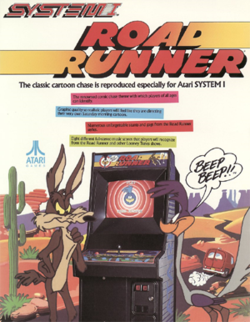m (trying to fix details) |
m (Update infobox) |
||
| (16 intermediate revisions by 6 users not shown) | |||
| Line 1: | Line 1: | ||
{{Header Nav|game=Road Runner (1985) | {{Header Nav|game=Road Runner (1985)}} | ||
{{ | {{Game | ||
|completion=2 | |||
|image=Roadrunflyer.png | |||
|title=Road Runner | |title=Road Runner | ||
|developer=[[Atari Games]] | |developer=[[Atari Games]] | ||
|publisher={{ | |publisher={{colist|Atari Games|U.S. Gold|Mindscape|Tengen}} | ||
| | |year=1985 | ||
|systems={{syslist|cade|cpc|a2600|atarist|c64|msdos|zx|nes}} | |||
|genre=[[Platform]] | |genre=[[Platform]] | ||
|players=1-2 | |players=1-2 | ||
|modes=[[Single player]], [[Multiplayer]] | |||
|series=Road Runner | |||
|pcgamingwiki=Road Runner | |||
}} | }} | ||
{{game disambig|the game featuring Warner Bros. characters|the original game with the same name|[[Road Runner]] (a.k.a. Desert Gun)|the [[1983]] [[BBC Micro]] racing game|[[Road Runner (1983)]]}} | |||
{{marquee|Roadrunmarq.jpg}} | {{marquee|Roadrunmarq.jpg}} | ||
'''Road Runner''' is a variant of the [[platform]] genre, based on the Wile E. Coyote and Road Runner shorts. It was developed and released by [[Atari Games]] in [[1985]]. Road Runner was ported to the [[Amstrad CPC]], [[Atari 2600]], [[Atari ST]], [[Commodore 64]], [[DOS]], [[Sinclair ZX Spectrum]], and [[NES]]. Like other NES games released by [[Tengen]], the NES version of Road Runner was released in an unlicensed cartridge. | '''Road Runner''' is a variant of the [[platform]] genre, based on the Wile E. Coyote and Road Runner shorts. It was developed and released by [[Atari Games]] in [[1985]]. Road Runner was ported to the [[Amstrad CPC]], [[Atari 2600]], [[Atari ST]], [[Commodore 64]], [[DOS]], [[Sinclair ZX Spectrum]], and [[NES]]. Like other NES games released by [[Tengen]], the NES version of Road Runner was released in an unlicensed cartridge. | ||
The player portrays the Road Runner, who must outmaneuver and outsmart Wile E. Coyote while eating seeds along the way in order to stay alive. The game also has full-stereo music scores from Road Runner and other Looney Tunes. One unusual feature is the screen scrolls constantly from right to left, unlike almost every other game that scrolls normally from left to right. | |||
An early original prototype of this game was Laserdisc based, with cartoon intermissions | |||
showing at the beginning, in-between levels, and at the end. This was not released to | |||
the public, and a regular board based arcade machine became standard. | |||
{{ToC}} | {{ToC}} | ||
{{Road Runner}} | |||
[[Category:Atari Games]] | |||
[[Category:Platform]] | [[Category:Platform]] | ||
[[Category:Single player]] | [[Category:Single player]] | ||
[[Category:Multiplayer]] | [[Category:Multiplayer]] | ||
[[Category:MAME]] | [[Category:MAME]] | ||
Latest revision as of 07:33, 26 July 2022
This is the first game in the Road Runner series. For other games in the series see the Road Runner category.

| Road Runner | |
|---|---|
| Developer(s) | Atari Games |
| Publisher(s) | Atari Games, U.S. Gold, Mindscape, Tengen |
| Year released | 1985 |
| System(s) | Arcade, Amstrad CPC, Atari 2600, Atari ST, Commodore 64/128, DOS, Sinclair ZX Spectrum, NES |
| Series | Road Runner |
| Genre(s) | Platform |
|---|---|
| Players | 1-2 |
| Modes | Single player, Multiplayer |
- This guide is for the game featuring Warner Bros. characters. For the original game with the same name, see Road Runner (a.k.a. Desert Gun). For the 1983 BBC Micro racing game, see Road Runner (1983).
Road Runner is a variant of the platform genre, based on the Wile E. Coyote and Road Runner shorts. It was developed and released by Atari Games in 1985. Road Runner was ported to the Amstrad CPC, Atari 2600, Atari ST, Commodore 64, DOS, Sinclair ZX Spectrum, and NES. Like other NES games released by Tengen, the NES version of Road Runner was released in an unlicensed cartridge.
The player portrays the Road Runner, who must outmaneuver and outsmart Wile E. Coyote while eating seeds along the way in order to stay alive. The game also has full-stereo music scores from Road Runner and other Looney Tunes. One unusual feature is the screen scrolls constantly from right to left, unlike almost every other game that scrolls normally from left to right.
An early original prototype of this game was Laserdisc based, with cartoon intermissions showing at the beginning, in-between levels, and at the end. This was not released to the public, and a regular board based arcade machine became standard.
